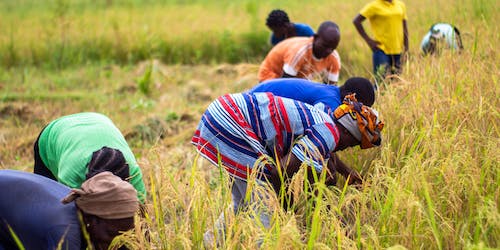Cassava farming is a tremendously profitable agribusiness, particularly in Nigeria and other West African countries. You can’t afford to be in Nigeria and not want to start growing cassava as soon as you finish reading our cassava farming guide.
In this guide, we’ll look at everything you need to know to get started with cassava farming in Nigeria, including business opportunities in cassava farming, the benefits and challenges of cassava farming, as well as how to care for your farm.
What Is Cassava?
Cassava, formally known as Manihot esculenta, is a starchy root vegetable widely farmed and consumed in Nigeria. It is an essential staple crop used in many traditional recipes and a source of income for many small-scale farmers.
What Is Cassava Farming?
Cassava farming is the cultivation of cassava plants for food, feed, and industrial uses. Cassava farming has become a major agricultural enterprise in Nigeria due to the numerous benefits and business opportunities it offers. The crop is used for various purposes, such as food, animal feed, alcohol production, starch production, and biofuel production. Cassava farming is an important source of livelihood for millions of farmers in Nigeria, and it has the potential to contribute significantly to the country’s economic growth and development.
How To Start a Cassava Farming Business in Nigeria
In this section, we’ll take a look at the basics of starting a cassava farming business in Nigeria.
#1. Conduct Research and Feasibility Studies
Before beginning cassava farming, it is critical to research and analyse the crop to understand its demands, market value, and possible profit margins. Determine the optimal planting season and varieties suitable for your soil type.
#2. Acquire Farmland
After conducting your research, secure farmland suited for cassava farming with well-drained soil that is not waterlogged.
#3. Prepare the Land
Clear the area and create ridges or mounds for planting using either equipment or hand effort.
#4. Get Quality Cassava Stems
Purchase high-quality cassava stems from reputable sources, and avoid stems that have been contaminated by pests or illnesses.
#5. Planting
Cut the stems into pieces and plant them in the ridges, making sure they are not too deep in the soil. Plant during the rainy season and keep the soil moist.
#6. Maintain the Farm
Weed the farm regularly, apply fertiliser as needed, and make sure it is well-drained and watered when necessary
#7. Harvesting
Cassava should be harvested between 8 and 12 months after planting, and only mature cassava should be harvested because immature cassava may not have attained its potential production.
#8. Marketing
Sell your cassava goods to a variety of buyers, including local marketplaces, processing plants, and exporters.
#9. Continuously Improve
Look for ways to increase farm productivity and profitability by attending seminars and workshops on contemporary farming practices and technologies.
Cassava Farming Methods in Nigeria
Cassava farming in Nigeria is divided into two types: subsistence farming and commercial farming
#1. Subsistence Cassava Farming
It is practised by small-scale farmers who cultivate cassava primarily for household consumption or sale at local markets.
#2. Commercial Cassava Farming
It involves large-scale cassava cultivation for sale to the industrial market; the farms are often mechanised, with high input and output.
Other types of cassava farming include intercropping, in which cassava is grown alongside other crops, and organic cassava farming, in which no synthetic chemicals are used in the growth process.
How To Plant Your Cassava
Following the completion of land preparation, you begin planting cassava by:
- Pushing the cassava stem’s bottom to the ground.
- The stems are planted on mounds and/or ridges.
- Ensure that the stems are planted while the soil is wet, particularly at the beginning of a rainy season.
- Plant the stems vertically or slantingly.
- Pushing the stem deep into the ground while leaving two buds above ground.
- Using your fingers, press the ridge around the stem. This will cause the roots to grow and be adequately fed.
- Maintaining the recommended cassava spacing of 1.5 meters.
Cassava planting should begin in October, at the start of the brief rainy season. As a result, cassava matures swiftly. Early-maturing, high-yielding types are harvested 6-7 months after planting, while late-maturing varieties might be harvested after a year.
Cassava Processing and Packaging in Nigeria
The cassava processing business in Nigeria holds a lot of prospects for generational wealth. The equipment for cassava processing is expensive, but it’s worth it. The following are the procedures for processing and packaging cassava
#1. Harvesting
Cassava is ready for harvest 9-12 months after planting, depending on the variety, and is harvested by cutting the stem of the cassava plant with a machete or hoe, leaving the tubers in the ground.
#2. Washing and Peeling
Cassava tubers are washed after harvesting to remove dirt and other impurities and then peeled using a sharp knife or cassava peeling machine to remove the outer brown covering.
#3. Grating
The peeled cassava is grated with a grater or a cassava processing machine, which breaks the cassava down into smaller pieces for easy processing.
#4. Pressing
The grated cassava is placed in a hydraulic press or a manual press to remove excess water, which reduces the water content in the cassava and makes it easier to process and package.
#5. Drying
The pressed cassava is placed on a flat surface to dry in the sun or in a drying machine, which reduces the moisture content of the cassava and makes it ready for processing into various products.
#6. Milling
Using a milling machine, dried cassava is milled into flour, which is then used to manufacture cassava-based goods such as gari, fufu, and tapioca.
#7. Packaging
To keep the cassava flour fresh and prevent contamination, it is packaged in airtight bags or containers.
#8. Storage and Distribution
To prevent deterioration, the packaged cassava flour is kept cool and dry, and it can be distributed to different marketplaces and offered to consumers.
Cassava Farming Business Opportunities in Nigeria
The government of Nigeria is investing in the cassava industry, which is creating new opportunities for businesses. Here are 7 cassava farming business opportunities in Nigeria
#1. Cassava Processing
Because there is a large demand for processed cassava products such as flour, starch, and chips, which are used in a variety of industries such as food, textiles, and paper, cassava farmers have a big chance to delve into cassava processing.
#2. Biofuel Production
Cassava is a rich source of starch that may be transformed into biofuel, providing cassava farmers with a large financial opportunity to supply raw materials to biofuel makers.
#3. Ethanol Production
As the need for ethanol as a gasoline additive grows, cassava is a feasible source of ethanol production, as cassava farmers may offer raw materials to ethanol companies.
#4. Textile Production
Cassava fibres can be turned into textiles, providing cassava farmers with an opportunity to enter the textile business.
#5. Alcohol Production
Cassava may be fermented to generate alcoholic beverages such as beer and wine, and cassava farmers can enter the alcohol production business as a value-added endeavor.
#6. Medicine Production
Cassava has medical characteristics and is used to make numerous medications; cassava growers can offer cassava roots to pharmaceutical businesses.
#7. Export
Demand for cassava products is high in other African countries and abroad, providing cassava growers with an excellent opportunity to export their products and earn foreign cash.
Cassava Farming Benefits in Nigeria
Cassava farming is a significant economic activity in Nigeria and throughout Africa, bringing numerous benefits to farmers, consumers, and the whole economy. The following are the six advantages of cassava cultivation in Nigeria and Africa:
#1. Food Security
Cassava is a staple food crop in many African countries, providing a consistent source of food for millions of people.
#2. Income Generation
Cassava farming is a significant source of income for smallholder farmers, as well as a source of employment and income for rural communities.
#3. Drought Resistance
Cassava is drought-resistant and can grow in poor conditions, making it an important crop for food security in areas with erratic rainfall.
#4. Soil Fertility
Cassava farming can improve soil fertility because the crop’s deep root structure breaks up compacted soils and increases soil organic matter.
#5. Climate Resilience
Cassava is an important crop for climate resilience since it can withstand a wide variety of temperatures and is pest and disease-resistant.
#6. Nutritional Value
Cassava is a good source of carbs, vitamins, and minerals and is a good source of food for people who are malnourished.
Cassava Farming Challenges in Nigeria
While there are many opportunities for cassava farmers in Nigeria, there are also several challenges. Here are six challenges that cassava farmers in Nigeria may face
#1. Pests and Diseases
Cassava is vulnerable to pests and diseases, which can affect output dramatically.
#2. Inadequate Availability of Quality Seeds
While quality seeds are essential for successful cassava production, many farmers may not have them.
#3. Climate Change
Climate change can hurt cassava output due to changes in rainfall patterns, temperature, and extreme weather events.
#4. Finance Availability
Many smallholder farmers may lack the finances to purchase inputs or invest in their fields.
Poor soil quality: Cassava grows best in well-drained, fertile soil, which many farmers may not have access to.
#5. High Labour Costs
Cassava farming necessitates a substantial amount of labour, which can be costly for farmers.
#6. Inadequate Processing Facilities
Many smallholder farmers may lack access to processing facilities that would allow them to add value to their cassava products.
How To Maintain Your Cassava Farm
Running a farm takes dedication and skill; even if you are new to the occupation, you need to develop the expertise you need to maintain the farm successfully. Some of these ways include
#1. Weeding
Weeding a cassava farm is recommended after planting in the first growth phase on the fourth, eighth, and twelfth weeks. The easiest technique to control weeds on a cassava farm is to combine hand clearing with the application of herbicides such as atrazine and diuron.
#2. Irrigation
Although cassava can withstand prolonged drought, it is extremely sensitive to a decrease in soil water level during the first three months after planting. Cassava is primarily a rain-fed cash crop, but in the event of an unexpected drought, the crop must be watered.
#3. Fertiliser
Mineral fertilisers can assist in raising output, but they cannot do it alone; green manure and animal dung are also required to improve total harvest quality and quantity. Fertiliser should be applied 8 weeks after planting, in a ring around a ridge, with the fertiliser not touching the stem or the plant.
Cassava Pests and Diseases
Pests and illnesses are among the leading causes of agribusiness failure. Cassava is plagued by the following pests and diseases:
#1. Mites and Thrips
Miticides and insect growth regulators can be used to control thrips and mites. These pests are more widespread during dry seasons and become less prevalent when rainfall increases.
#2. The virus that infects cassava
The African cassava mosaic virus causes the cassava plant’s leaves to wither. When this happens, the root’s growth is hampered. Planting resistant cultivars is the most effective control method.
#3. Mealybug of cassava
This shortens the internode length of the cassava stem. This bug can cause up to 80% crop loss, which is severely harmful to subsistence farmers’ production.
#4. Insects
Locusts, for example, eat cassava leaves and have a direct impact on the plant. Ants and termites consume cassava stems after planting or later in the season, destroying entire plants.
How Much is One Tonne of Cassava in Nigeria?
The price of cassava per tonne in Nigeria ranges from ₦30,000 to ₦80,000. The price of cassava per ton is affected by a lot of factors.
How Can Cassava Yield be Increased?
The mother plants of the stakes should have been adequately fertilised to ensure high yields. Cassava plants grown in soil low in nitrogen, phosphorus, and potassium yield stakes low in those nutrients as well as starch, reducing sugars, and total sugars.
What is the Best Fertiliser for Cassava Farms?
Two types of fertilisers are used to grow cassava crops: compound fertilisers that provide several nutrients together and single-nutrient fertilisers
How Many Times a Year can Cassava be Harvested?
Harvesting the plant tops four or five times during a one-year growth cycle removes a large amount of nutrients, particularly nitrogen, from the field and would be unsustainable without the application of large amounts of mineral fertiliser to maintain soil fertility.
Which Country Buys Cassava From Nigeria?
The principal markets for cassava products are in Europe – the European Economic Community being the most important for dried roots – and for cassava starch in the United States, the United Kingdom and Japan.
Conclusion
Cassava farming represents a big potential for farmers and businesspeople in Nigeria and throughout Africa. Cassava’s versatility as a food and industrial crop makes it a significant asset that can contribute to regional food security and economic development.
However, difficulties like disease and pests, a lack of access to finance and markets, and low mechanisation must be solved if cassava farming is to reach its full potential. Overall, cassava farming in Nigeria and Africa has enormous potential to contribute to agricultural growth and development, enhance revenue for farmers and entrepreneurs, and improve food security and nutrition in the region.
- What Is Garri: Complete Business Guide 2023
- STARTING A BUSINESS IN TEXAS: Checklist, Costs, and Requirements
- What is Commercial Farming? All You Need To Know 2023
- HARVEST TIME TRACKER: Harvest Software Reviews & Pricing 2023
- PEST ANALYSIS: Meaning, Importance, and Application






